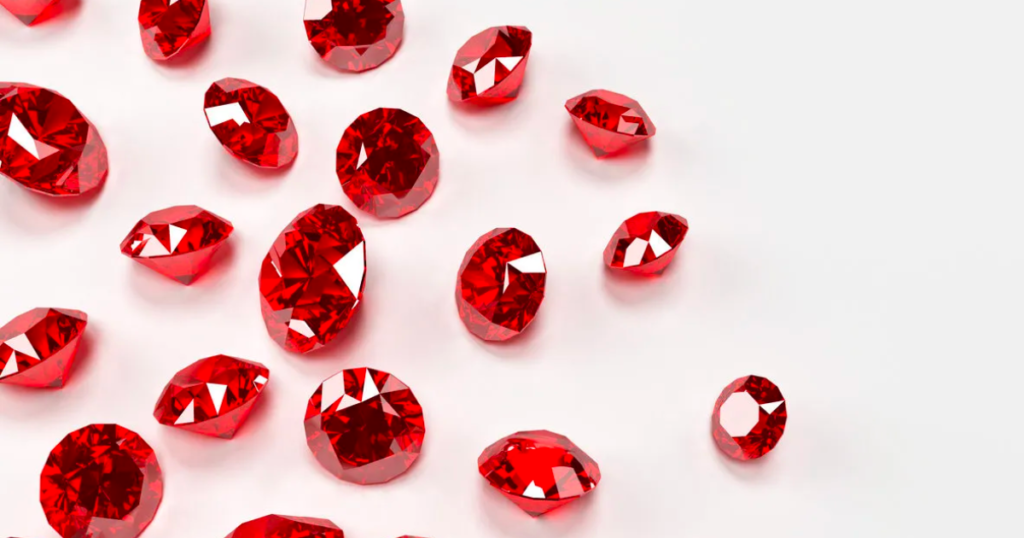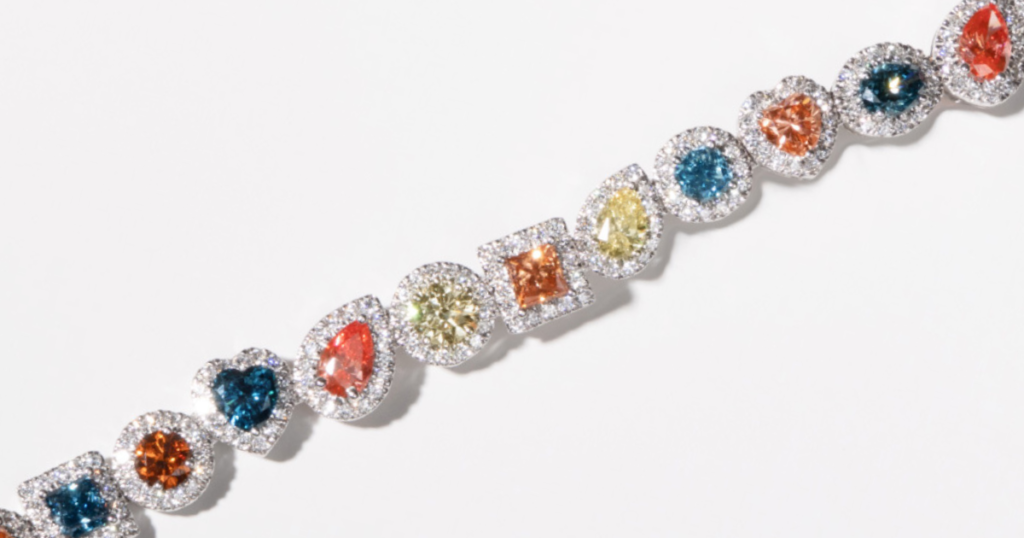Ruby is the July birthstone, and it’s one of the most coveted and precious gems. The most valuable type of ruby is called the “pigeon’s blood” or “Burmese” ruby, a deep red with a hint of blue.
Ruby gemstones are a variety of the mineral corundum, so they get their color from the element chromium. Here’s what you need to know about July’s birthstone so you can better choose one for yourself or a loved one who wants the iconic gem!
The following is for educational purposes only, as we do not carry ruby or lab grown ruby in our catalog at Clean Origin.
History of Rubies

Ancient
Since the earliest eras of civilization, rubies have captivated humankind as treasures beyond price. Ancient texts from cultures across the globe pay homage to their rarity and allure. In centuries-old Sanskrit scripts, these crimson stones were honored with the title “ratnaraj,” or “king of precious gems,” elevating rubies to royalty among jewels. For millennia, their rich color and mystic energy have enthralled kings and commoners alike. To adorn oneself in ruby’s radiance was to tap into its legend, its lore, its power. For thousands of years, these peerless red gems have reigned, demanding reverence, sparking obsession – true heirlooms of antiquity.
Burmese
Of all the storied locales that yield the earth’s rubies, Burma (now Myanmar) has long glittered above the rest as the world’s most vaunted source of supreme quality gems. Its remote Mogok Valley, in particular, has captured the imaginations of jewelry aficionados for centuries as the birthplace of exceptionally pure “pigeon’s blood” rubies, prized for their deep, intense crimson hue. Treasured in Asian royalty and nobility since eras past, these legendary Burmese rubies possess a mystery and grandeur that has become woven into fable. Their rich red colors conjure images of ancient kingdoms, dynasties long gone yet remembered for the rubies that once graced their crowns and adornments. Burma’s mythical valley still channels this bygone mystic aura into the rarest, most wondrous rubies – truly fit for royalty through the ages.
What Does the July Birthstone Represent?

In addition to being the July birthstone, ruby is traditionally given for the 15th and 40th wedding anniversaries, and many couples even use it as their engagement or wedding ring.
The name comes from the Latin word ruber, meaning “red,” the color of love and passion. The Ruby represents love, passion, courage, and emotion; whether or not you were born in July, owning a ruby is rare and special.
In ancient India, ruby was called the “king of precious stones” for its rarity, hardness, beauty, and seemingly mystical powers. Associated with the life-force blood, ruby is a symbol of power and youthful energy in Indian jewelry.
In past centuries, some believed this July birthstone could predict misfortune or danger, and others claimed it would cure inflammatory diseases and soothe anger. Burmese warriors believed it made them invincible in battle, and Medieval Europeans thought that rubies bestowed wisdom, wealth, and success in love.
As one of the cardinal gems, the brilliantly colored rubies have always been highly valued. Its durability only increases the ruby’s worth — rating at a 9 on the Mohs scale; it is a cousin of sapphires and only marginally softer than diamonds.
Pop Culture Ties to Ruby
The Wizard of Oz
Dorothy’s iconic ruby slippers from The Wizard of Oz film have some interesting connections to real rubies and their history:
- In L. Frank Baum’s original 1900 novel The Wonderful Wizard of Oz, Dorothy’s slippers were silver rather than ruby. The color was changed to ruby red for the 1939 film to show up better against the yellow brick road.
- The ruby slippers were meant to represent Dorothy’s journey down the yellow brick road. Symbolizing the richness and vibrancy of Oz.
- Real rubies have long been associated with royalty, nobility, and luxury. As one of the most coveted gems in history, rubies convey a sense of power, importance, and rarity.
- The slippers become a protective talisman for Dorothy, saving her from danger. This reflects how rubies were thought in ancient times to endow their wearers with safety, energy, and invincibility.
- Dorothy’s slippers are a distinctive shade that stands out boldly, much like high-quality rubies’ rich, intense red hue.
- The slippers represent Dorothy’s journey home, becoming one of the most iconic symbols of The Wizard of Oz. Similarly, real rubies have remained among the most treasured and iconic gemstones across many cultures for centuries.
Titanic
The famous fictional Heart of the Ocean necklace from the film Titanic has some interesting ties to real rubies:
- The enormous blue diamond at the center of the necklace was patterned after the Hope Diamond, which has a long history intertwined with rubies. The Hope Diamond was originally part of a larger gem surrounded by red rubies.
- In the film, the Heart of the Ocean was commissioned by Louis XVI and was worn by Marie Antoinette before ending up on the Titanic. Rubies were beloved by French royalty and featured heavily in the French Crown Jewels.
- The ruby and diamond combination was popular in Edwardian jewelry of the early 1900s when the Titanic sank. Blue diamonds complemented deep red rubies.
- As one of the most prized gemstones, rubies symbolize passion, power, and privilege – giving the Heart of the Ocean its air of importance, luxury, and mystery.
- The vivid blue stone pops against Rose’s red hair in the film, just as Ruby’s rich red color dramatically contrasts blue sapphires and diamonds.
- After being lost for decades, the necklace is uncovered 85 years later, still emanating its allure. Similarly, rubies have maintained intrigue and value for centuries since ancient times.
- The Heart of the Ocean connects Rose to her memories of Jack and Titanic. In a similar way, rubies connect emotional associations for wearers.
- Given that, the necklace holds symbolic and sentimental value as an iconic cinematic jewelry piece.
Lab Grown Rubies

Lab grown rubies are mined gem alternatives, created under controlled and monitored conditions with cutting-edge technology. In short, a “seed” is introduced by a natural ruby. It creates a ruby with the same chemical, physical, and optical characteristics as a mined ruby.
They have the impurities and the same range of cut, clarity, color, and weight that you’d find in mined gems. Also, some of the more famous laboratory gemstones are sapphires and emeralds.
The Liberty Bell Ruby
Molded by master sculptor Alfonso de Vivar, the Liberty Bell Ruby (LBR) crystallizes an American emblem from the earth’s rarest crimson bounty. Forged from an uncut 8,500-carat monster ruby unearthed in the Foothills of North Carolina, it rings loud as the world’s largest mined gem of its kind. Unveiled in 2011 at New Orleans’ Museum of Art, this marks the USA Ruby Association’s 35th anniversary by fusing heritage and history. Albeit valued up to $3 million, the Bell remains in its natural state, flaunting the primal potency of elementally-formed ruby.
Accordingly, its rich, saturated color pays homage to Ruby’s legendary passions and vibrancy. Born on America’s soil, this mighty Bell marks a milestone for domestic ruby mining. Contrarily, it chimes universal tones of liberty. Its chosen shape highlights Ruby’s ancient associations with power and protection. An objet d’art melding antiquity with modernity, the LBR sings in blood-red volumes of humanity’s endless pursuit of freedom.
Diamond vs. Ruby
| Mined Diamonds | Lab Grown Diamonds | Rubies |
| Made from Carbon | Made from Carbon | Made from Corundum |
| Mohs Hardness Level = 10 | Mohs Hardness Level = 10 | Mohs Hardness Level = 9 |
| Refractive Index = 2.42 | Refractive Index = 2.42 | Refractive Index = 1.76-1.77 |
Which Should I Buy?

Trying to decide between gems or jewelry for yourself or a loved one? Here are the pros and cons of both diamonds and rubies!
The Pros of Lab Grown Diamonds:
- Firstly, there is an incredibly high demand for diamonds.
- The hardest mineral, not prone to breaking or scratches
- Ethically and sustainably sourced, so you’ll have a clear conscience!
- Up to 50% less expensive than mined diamonds
The Cons of Lab Grown Diamonds:
- Lab grown diamonds are so new and technologically advanced, and some do not understand that they are exactly the same as mined diamonds.
The Pros of Rubies:
- Colorful and unique, breaking from tradition
- The July Birthstone — could be more significant and sentimental to those who were born in July
- Most rubies are lab grown these days, which makes them ethically sourced!
- As a result, they can be less expensive than diamonds, depending on the four C’s
The Cons of Rubies:
- Conversely, they are not as valuable or sought after as diamonds.
- Softer than diamonds; therefore, it’s easier to scratch or break them. Not ideal for everyday wear.



